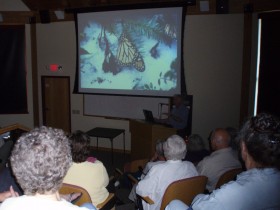 TRAILS: Groomed on Saturday. Excellent.
TRAILS: Groomed on Saturday. Excellent.
You heard it hear first folks, at least if you attended the Monarch Weekend last June at Crossroads at Big Creek. Our keynote speaker, Dr. Lincoln Brower, has been splashed over the international news talking about the alarming decline in monarch butterflies, or as Dr. Brower stated last summer, “the [monarch] migration is definitely proving to be an endangered biological phenomenon.”
During his program at Crossroads, Brower blamed current intensive farming practices through the Midwest…the monarch’s migrational route. Monarchs butterflies truly are finicky, laying their eggs only on milkweed plants. If milkweed plants are not available, the monarchs will not be able to lay their eggs. And without several generations of caterpillars, there will be no butterflies to make the autumn trip to Mexico. We found that to be the case here in Door County. Sadly, the trend was very wide spread.
It is simple. No host plants. No butterflies. Most people are aware of the monarch’s plight. But until I read the book, Bringing Nature Home: How you Can Sustain Wildlife with Native Plants by Douglas Tallamy, I did not realize that “Up to 90% of phytophagous (plant-eating) insects are considered specialists because they have evolved in concert with no more that a few plant lineages …….Insects are able to eat only vegetation from plants with which they share an evolutionary history .” In other words, native Wisconsin insects can eat only one or two kinds of native Wisconsin plants. All other plants are, to them, distasteful or even poisonous.
Yet when we landscape our properties, we tend plant trees and ornamental plants which have come from other parts of the world. And that’s the cause of one of the gardeners nightmares. Alien plants attract alien insects….insects with no natural predators. Bad news.
Maybe worse news: many ornamental plants now have become invasive species. Don’t get me started on that.
But the point Tallamy makes that spoke to me was that if we don’t have caterpillars, there will not be food for baby birds. That’s what nestlings eat. Even seed and fruit eating birds feed their offspring protein-rich insects. And where there are no caterpillars, there will be far fewer birds.
Many people landscape for birds by planting trees with nuts and berries, but by planting the host plants for the butterflies and moths, they could make their yards must more inviting as wildlife habitat.
Our friends from Wild Ones have a great saying: “If nothing moves in your landscape but a lawnmower, it’s time to think about designing a natural yard.”
And if you are thinking about landscaping, you will want to attend Master Garden lecture on Tuesday, February 25 at 7:00 when Master Gardeners offers a Lecture: Professional Landscaping. This program will provide you with information about the landscaper-customer design process. It will include discussion about creative plantings of flowers, shrubs and trees that grow well in northeast Wisconsin, and the use of paths, water features, rock walls and other hardscape designs to enhance your outdoor living spaces. The program will also include “before and after” illustrations of landscaping, from high-end large projects through medium size and smaller projects. Our guest speaker will be Greg Meissner, Co-owner of Meissner Landscape, Inc., a firm that has been providing professional, high quality landscape service in Door County and northeast Wisconsin, since 1982.

